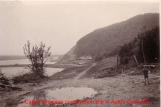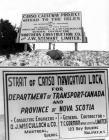2
BEGIN CLEARING SITE FOR CANSO CAUSEWAY - Auld's Cove -June 4 - "Workmen today began clearing a campsite at this northern Nova Scotia settlement for use by two Vancouver construction firms doing preliminary rock fill work on the Canso Causeway. F.D. Chase of Vancouver, job superintendent, put 148 men from this area to work. The job is estimated to take three weeks. Mr. Chase said that there would be no activity on the Cape Breton side this summer. The causeway will link Cape Breton with mainland Nova Scotia".(The Victoria Inverness Bulletin June 11,1952)
4
SITE PREPARATION - Northern Construction and J.W. Stewart Limited hired men to build roads, install scales, erect workshops to house heavy machinery and equipment, and to build bunk houses for the construction workers. The ceremony to mark the official start wouldn't take place until September 16, 1952.6
PARTNERS IN CANSO CAUSEWAY AND CANAL CONSTRUCTION - The Canso Causeway and Canal were constructed between 1952 and 1955 under a tri-party agreement between the federal Department of Transport, the Nova Scotia Department of Highways and the Canadian National Railway.Funding was provided by the Department of Transport under this agreement to provide a fixed link between mainland Nova Scotia and Cape Breton Island to replace a marine ferry crossing between the town of Mulgrave and Port Hawkesbury and Mulgrave and Point Tupper.
8
THE CAUSEWAY AND CANAL BUILDERS - The same engineering firm designed both projects, but different contractors won the bids to construct each.L.J. Doucet, in his book The Road to the Isle: The World's Deepest Causeway, discusses the awarding of the tenders:
"Eventually the job of preparing actual plans for the causeway, the locks and the swinging bridge was awarded to the O.J. McCulloch Engineering Company of Montreal and early in 1952 the Department of Transport announced it was ready to accept tenders for the job.
"... on May 15th, 1952, when the first contract was awarded to the Vancouver firm of Northern Construction and J.W. Stewart Limited. This contract covered the causeway proper and the shore approaches on the mainland side. Construction on the lock system and the highway approach from Cape Breton was contracted to the T.C. Gorman Construction Company of Montreal. The job of preparing the railway approach on both sides and other smaller contracts were awarded to separate companies."
11
OFFICIAL START OF CONSTRUCTION -The rock used to bridge the Strait of Canso came from a close source, the mountain overlooking it. Cape Porcupine, on the mainland side of the Strait of Canso, provided the slightly more than ten million tons of rock used to build the Canso Causeway.The site preparation began in June and July 1952 but the marking of the official start of construction was September 16th, 1952.
12
Honourable Lioniel Chevrier and Premier Angus L. MacdonaldSeptember, 1952
Canso Causeway work site

13
CEREMONY FOR OFFICIAL START OF PROJECT- September 16th, 1952Honourable Lionel Chevrier,Federal Transport Minister (left) set off the dynamite charge that day. A description of the blast appeared in the Cape Breton Post Record. "Chevrier set off an eight ton charge of dynamite that lifted 40,000 tons of rock debris from the face of Porcupine Mountain and shifted it helter,skelter into the Strait of Canso. When the great slide rolled and roared into the water, it created a minor tidal wave aided and abetted by the accompanying concussion of the blast."
Premier of Nova Scotia, Angus L. Macdonald rode along in the Euclid truck and upon reaching the water's edge, took control of the machine and dumped the first official load of what would be part of ten million two hundred thousand tons of rock required for the project.






